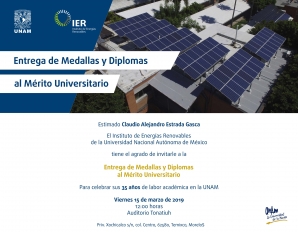A Piña-Ortiz, JF Hinojosa, RA Perez-Enciso, VM Maytorena, C Estrada, CA Pérez-Rábago, RA Calleja
Abstract
In the city of Hermosillo, in the northwestern state of Sonora, México, the University of Sonora in agreement with the National Autonomous University of México is developing solar tower technology. A thermal receiver was designed to measure the thermal power of a small number of heliostats and experimental results were obtained to measure the thermal power of a small number of heliostats. The flat plate thermal receiver is a parallelepiped enclosure 1.20 m high, 1.23 m wide and 0.1 m deep with a receiving area of 1.476 m2 and a ε = 0.95, It also has 1228 cylindrical fins evenly distributed in the interior, each fin has a diameter of 0.0095 m and a length of 0.09 m, which increases the area of the receiving wall by up to 329%. Three experiments (with 1, 4 and 7 heliostats respectively) were carried out using the effect of the radiative flux provided on: the estimated thermal power, thermal efficiency, temperature distribution of the internal surface of the receiving wall (plate), the temperature distribution in the fins and in the fluid; all of this during steady state conditions. The experiments were performed for a Re⎯⎯⎯⎯ number of 2.90 × 104; it was found that the thermal efficiency of the system decreases as the radiative flux increases. The maximum efficiency was 84.9% and the minimum was 58.4% for experiment 1 and 3 respectively. We also observe that the temperature gradients of the fins increase as the radiative flux increases and that the fluid increases its temperature as it passes through the receiver and the center of the plate has the higher temperatures.

